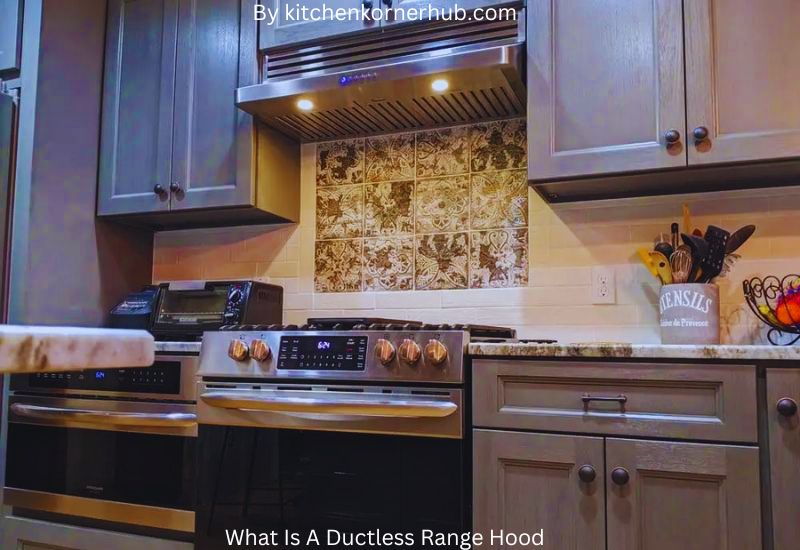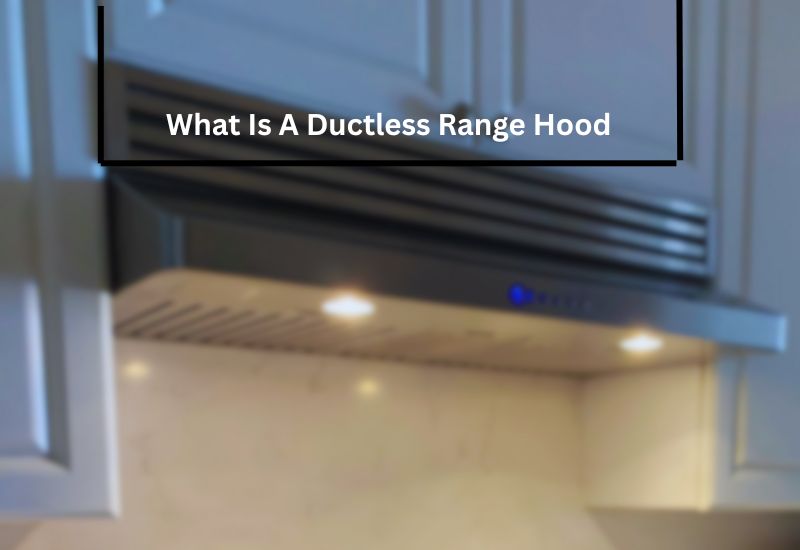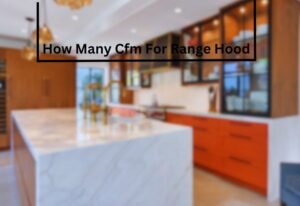If you’ve spent time in a kitchen, you’re likely familiar with the importance of ventilation, especially when it comes to cooking. A ductless range hood is a kitchen appliance designed to improve air quality and eliminate odors, steam, and smoke that arise during cooking. But what exactly is a ductless range hood, and how does it work? In this article, we’ll break down the basics in easy-to-understand terms.
Ductless range hoods, also known as recirculating range hoods, are a popular solution for kitchens that lack a ventilation system or an external duct. They consist of a fan and a series of filters, which play a crucial role in purifying the air. Instead of expelling the air outside through a duct, like traditional range hoods do, ductless range hoods pull in the air, filter out impurities, and then release the clean air back into the kitchen. This process helps improve indoor air quality, making the kitchen a more comfortable and pleasant space to cook in.
What Is A Ductless Range Hood? A ductless range hood is a kitchen appliance designed to remove smoke, odors, and grease particles produced during cooking. Unlike traditional range hoods that require external ventilation, a ductless range hood uses filters to trap and purify the air before recirculating it back into the kitchen, making it suitable for spaces without ductwork.
In the following sections, we’ll delve deeper into how ductless range hoods function, their advantages and limitations, and whether they might be the right choice for your kitchen setup. So, if you’re curious about maintaining a fresh and odor-free kitchen environment, keep reading to learn more about ductless range hoods.
Introduction to Ductless Range Hoods

In modern kitchens, the role of ventilation is paramount in maintaining air quality and preventing the buildup of odors, grease, and smoke. Ductless range hoods have emerged as a versatile solution to address these concerns. Unlike traditional ducted range hoods that expel air outdoors through a ventilation system, ductless range hoods operate by recirculating the air within the kitchen space. This innovative approach presents a range of benefits and considerations that are worth exploring.
Advantages of Ductless Range Hoods
Ductless range hoods offer several distinct advantages, making them a popular choice for homeowners and chefs alike. One of the primary benefits is their flexibility in installation. Since ductless hoods do not require a complex ductwork system, they can be easily placed in various locations within the kitchen, allowing for creative design and layout options. Additionally, ductless hoods tend to be more cost-effective during installation, as they eliminate the need for extensive ducting work, making them a suitable option for both new constructions and renovations.
Working Mechanism and Filtration System
The working mechanism of a ductless range hood involves a multi-step process that effectively filters and cleans the air. The hood first captures the cooking byproducts, such as grease, smoke, and odors, through its intake vent. The contaminated air then passes through a series of filters, typically including grease filters, charcoal filters, and sometimes even HEPA filters. These filters work collaboratively to trap grease particles and neutralize odorous molecules, ensuring that the recirculated air is significantly cleaner and fresher. Regular maintenance of these filters is essential to uphold the efficiency of the hood’s filtration system.
Limitations and Considerations
While ductless range hoods offer various advantages, it’s important to acknowledge their limitations and consider specific factors before opting for one. The effectiveness of a ductless hood largely depends on the quality and capacity of its filters. Cheaper or lower-quality filters may require more frequent replacements, adding to maintenance costs. Additionally, while ductless hoods can eliminate odors and some smoke, they might not be as efficient in removing large volumes of smoke generated by high-heat cooking methods. Therefore, the type of cooking frequently performed in the kitchen should influence the decision between a ducted and ductless range hood.
Maintenance and Filter Replacements
Proper maintenance is crucial to ensure the optimal performance of a ductless range hood. Regular cleaning of the hood’s interior, including the fans and filters, helps prevent the accumulation of grease and debris that can hinder its efficiency. The frequency of filter replacements depends on usage, cooking habits, and the type of filters installed. Grease filters typically need cleaning or replacement every few months, while charcoal or carbon filters might require replacement every six months to a year. Adhering to the manufacturer’s maintenance recommendations will prolong the lifespan of the range hood and maintain its ability to effectively clean and recirculate the air.
How Ductless Range Hoods Work

Ductless Range Hoods: An Introduction Ductless range hoods have revolutionized kitchen ventilation by providing an effective solution for removing cooking odors, smoke, and airborne particles without the need for an external duct system. These innovative appliances offer a compact and flexible alternative to traditional ducted range hoods, making them suitable for various kitchen layouts and installations.
The Mechanism Behind Ductless Range Hoods
Ductless range hoods operate through a combination of filtration and recirculation processes. When cooking fumes are generated, the range hood’s powerful fan draws in the air from the cooking area. This air passes through a series of filters, typically including a grease filter and a charcoal or carbon filter. The grease filter traps grease particles, preventing them from entering the fan and ductless components. Subsequently, the air moves through the carbon filter, which plays a pivotal role in neutralizing odors and capturing smoke particles. Once the air is filtered, it is recirculated back into the kitchen environment, significantly cleaner and fresher.
The Role of Carbon Filters Carbon filters,
also known as activated charcoal filters, are central to the effectiveness of ductless range hoods. These filters consist of numerous pores and a large surface area that efficiently absorb odorous molecules and volatile organic compounds (VOCs) present in cooking fumes. The activated charcoal within the filters chemically bonds with these molecules, effectively eliminating the source of the unpleasant smells. Over time, as the carbon filter becomes saturated, its ability to adsorb diminishes, necessitating periodic replacements to maintain the range hood’s efficiency.
Advantages of Ductless Range Hoods
Ductless range hoods offer several advantages that have contributed to their growing popularity. One key advantage is their ease of installation. Without the need for complex ductwork, homeowners can install these hoods in various locations, even in kitchens where traditional ducted systems might be challenging to implement. Additionally, ductless range hoods are energy-efficient, as they do not expel conditioned air from the kitchen space. This aspect is especially relevant in climates where heating or cooling expenses are a concern. Furthermore, their flexibility makes them suitable for apartment dwellers or those with rented properties, where making structural changes might not be possible.
Considerations and Maintenance
While ductless range hoods offer remarkable benefits, it’s important to consider their limitations. The recirculation process effectively filters the air, but it doesn’t entirely eliminate the need for venting cooking byproducts out of the living space. Regular maintenance, including cleaning or replacing filters as recommended by the manufacturer, is vital to ensure optimal performance. Homeowners should also be mindful of the specific type of cooking they engage in, as excessive frying or high-heat methods might result in increased filter saturation and more frequent replacements.
Advantages of Using Ductless Range Hoods

Ductless range hoods have gained popularity as efficient kitchen appliances due to their distinctive advantages. These hoods, also known as recirculating or ventless hoods, offer several benefits that make them a practical choice for homeowners.
Flexible Installation Options:
One significant advantage of ductless range hoods is their flexibility in installation. Unlike ducted hoods that require complex ductwork to expel air outside, ductless hoods operate by filtering the air through a series of charcoal and grease filters before recirculating it back into the kitchen. This eliminates the need for extensive duct installation, making it an ideal solution for homes without existing ductwork or kitchens located in apartments or older houses.
Cost-Effective Solution:
Ductless range hoods are often more cost-effective to install and maintain compared to their ducted counterparts. The absence of ductwork installation not only reduces upfront costs but also minimizes the need for ongoing maintenance and cleaning of ducts. This can lead to long-term savings in terms of energy consumption and maintenance expenses, making ductless hoods an attractive option for budget-conscious homeowners.
Versatile Placement:
Another advantage of ductless range hoods is their versatile placement within the kitchen. These hoods can be installed in various locations, such as above islands or in spaces where traditional ducted installations would be impractical. Their compact design and recirculation system allow for greater freedom in kitchen layout and design, enabling homeowners to optimize space usage without compromising on ventilation efficiency.
Simple Installation Process:
Installing a ductless range hood is generally easier and quicker compared to setting up a ducted system. The absence of complex ductwork simplifies the installation process, which can often be completed by homeowners with basic DIY skills. This simplicity also translates to reduced installation costs, as professional installation services may not be required, further contributing to the cost-effectiveness of the ductless option.
Enhanced Air Quality and Filtration:
Ductless range hoods utilize efficient filtration systems to remove smoke, odors, grease, and airborne particles from the kitchen environment. The charcoal and grease filters effectively trap these pollutants, resulting in improved indoor air quality. While ducted hoods expel contaminants outside, ductless hoods actively filter and recirculate the air, making them an excellent choice for kitchens in homes with limited ventilation options.
Considerations When Choosing a Ductless Range Hood

When it comes to selecting a ductless range hood for your kitchen, there are several key considerations that can influence your decision. A ductless range hood, also known as a recirculating range hood, offers the advantage of not requiring an external duct to vent the air outside. This makes it a practical choice for kitchens where duct installation might be challenging or impractical. However, before making your final choice, keep the following factors in mind to ensure you select the most suitable ductless range hood for your needs.
Filtration Efficiency and Type
The primary function of a ductless range hood is to filter and recirculate the air within your kitchen. It’s essential to consider the filtration efficiency and the type of filters used in the hood. Most ductless range hoods employ a combination of charcoal and grease filters. Charcoal filters absorb odors, while grease filters trap grease particles. Ensuring these filters are easy to access and replace is crucial for maintaining optimal performance. Some models even feature indicator lights that signal when filters need replacement, simplifying maintenance.
Noise Levels
Noise can be a concern, especially if your kitchen is an open-concept space or if you’re sensitive to sound. Different range hood models vary in noise levels, so it’s recommended to check the manufacturer’s specifications for the decibel rating. Quieter models often use advanced motor technology and improved fan design to minimize noise while maintaining efficient air circulation.
Size and Design
The size of the range hood and its design should harmonize with your kitchen’s aesthetics and layout. Consider the available space above your cooking area and select a size that adequately covers the cooking surface. Range hoods come in a variety of styles, from sleek stainless steel to modern glass designs. Choosing a style that complements your kitchen’s décor can enhance the overall visual appeal.
Installation and Ventilation Options
While ductless range hoods don’t require external ducting, proper installation is still essential. Some models might involve more complex installation processes, so reviewing the installation instructions and considering whether you’ll install it yourself or hire a professional is important. Additionally, certain range hoods offer the flexibility of being convertible to ducted systems if your kitchen’s ventilation needs change in the future.
Additional Features
Modern ductless range hoods often come with a range of features aimed at improving convenience and functionality. Look for features such as adjustable fan speeds, integrated lighting, and digital controls. Some high-end models might even include smart technology, allowing you to control the range hood using your smartphone or integrate it with your existing smart home ecosystem.
Installation and Maintenance of Ductless Range Hoods

Ductless range hoods have become a popular choice for kitchens due to their efficient ventilation without the need for external ductwork. Proper installation and maintenance of these hoods are crucial to ensuring their effectiveness and longevity.
Installation Steps:
Installing a ductless range hood involves several key steps. Begin by selecting an appropriate location, ideally centered above the cooking area, and ensure the hood is at least 24 to 30 inches above the cooktop for optimal capture of smoke and odors. Carefully follow the manufacturer’s guidelines for mounting the hood securely to the wall. As ductless hoods use filters to trap airborne particles, installing these filters correctly is vital. These can include grease filters and charcoal filters for odor absorption. Make sure to connect any necessary electrical components according to local regulations or seek professional assistance.
Ventilation and Filtration:
Ductless range hoods operate by filtering the air and recirculating it back into the kitchen. Grease filters are the first line of defense, capturing grease particles generated during cooking. Charcoal filters are essential for removing odors and improving indoor air quality. It’s crucial to clean or replace filters regularly, as dirty filters can hinder performance. Depending on usage, grease filters may need cleaning every 2-4 weeks, while charcoal filters might require replacement every 3-6 months.
Cleaning and Maintenance:
Regular cleaning is essential to maintain the efficiency of a ductless range hood. Grease can accumulate in the filters and on the interior surfaces of the hood over time. To clean the filters, remove them according to the manufacturer’s instructions and wash them with warm soapy water. Let them dry before reinserting. Wipe down the hood’s exterior with a mild detergent, avoiding abrasive materials that could damage the surface. Cleaning frequency depends on usage but performing a thorough cleaning every 1-2 months is a good rule of thumb.
Monitoring and Performance:
Monitoring the performance of your ductless range hood is crucial. If you notice a decrease in suction power or lingering odors, it may be time to clean or replace the filters. Regularly inspect the fan and motor for any unusual noises or vibrations, as these can indicate mechanical issues. Maintaining proper airflow is vital for the hood’s effectiveness, so avoid blocking the air vents and ensure there’s enough clearance around the cooking area.
Professional Maintenance:
While many maintenance tasks can be done by homeowners, it’s advisable to schedule professional maintenance at least once a year. A technician can perform a thorough inspection of the hood, clean hard-to-reach areas, and assess the overall functionality. They can also identify any potential issues before they escalate, ensuring the longevity and reliability of your ductless range hood.
Conclusion
In conclusion, a ductless range hood serves as a versatile and effective solution for kitchen ventilation. By employing a combination of filters and recirculation, it efficiently removes cooking odors, smoke, and airborne grease particles. While offering ease of installation and flexibility in placement, it might not be as potent as its ducted counterparts in expelling pollutants outside. The choice between ductless and ducted range hoods should be guided by kitchen layout, ventilation needs, and personal preferences. Ultimately, a ductless range hood emerges as a valuable option for those seeking practicality without compromising on air quality within their culinary space.
Frequently Asked Question(What Is A Ductless Range Hood)
Which is better duct or ductless range hood?
The choice between a ducted and a ductless range hood depends on your kitchen’s layout and your specific needs. Ducted range hoods are more effective at removing smoke, odors, and grease because they vent these pollutants outside your home. They require proper installation with ductwork, which can be a bit more complex and costly.
On the other hand, ductless range hoods use filters to trap grease and odors before recirculating clean air back into the kitchen. While they’re easier to install since they don’t need ductwork, they might not be as efficient as ducted hoods in terms of smoke and odor removal. Ultimately, the better option depends on your priorities. If you prioritize optimal ventilation and are willing to handle the installation process, a ducted range hood might be more suitable. However, if simplicity and ease of installation are key factors, a ductless range hood could be a good choice.
Are ductless range hoods any good?
Ductless range hoods can be a good option for kitchens where installing ductwork for a ducted range hood is impractical or too costly. They use filters to capture grease and odors, effectively improving the kitchen’s air quality. However, their performance might not be as high as that of ducted range hoods when it comes to eliminating smoke and strong odors.
It’s important to choose a ductless range hood with a good filtration system and to clean or replace the filters regularly for optimal performance. While they might not be as powerful as ducted hoods, modern ductless models have improved in effectiveness over time, making them a viable choice for kitchens without ducting options.
Do ductless range hoods need to be vented?
No, ductless range hoods do not need to be vented to the outside like ducted range hoods do. Instead of expelling air through a duct, ductless range hoods use filters to capture grease, smoke, and odors from the cooking process. Once the air is filtered, it’s recirculated back into the kitchen, providing a cleaner environment.
This lack of venting requirements makes ductless range hoods easier to install in various kitchen setups. However, it’s important to keep in mind that since they don’t expel air outdoors, they might not be as efficient at removing smoke and strong odors compared to ducted range hoods.
Where does the air go from a ductless range hood?
The air from a ductless range hood goes through a filtration process before being recirculated back into the kitchen. When you cook, the range hood’s filters capture grease particles, smoke, and odors. After passing through these filters, which are designed to trap and contain pollutants, the cleaner air is released back into the kitchen environment.
It’s worth noting that the efficiency of a ductless range hood’s filtration system depends on the quality of the filters and how well they’re maintained. Regularly cleaning or replacing the filters is essential to ensure the range hood continues to effectively improve the air quality in your kitchen.




